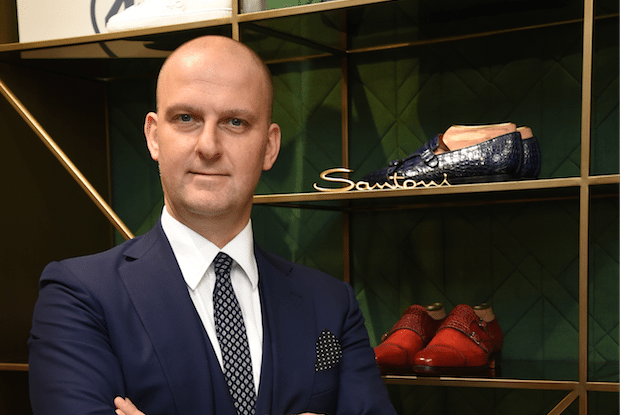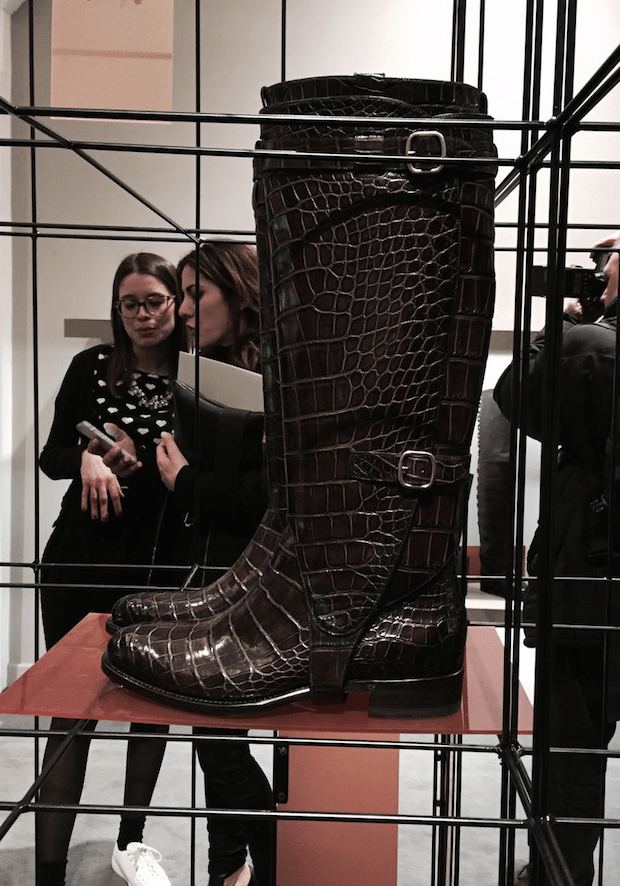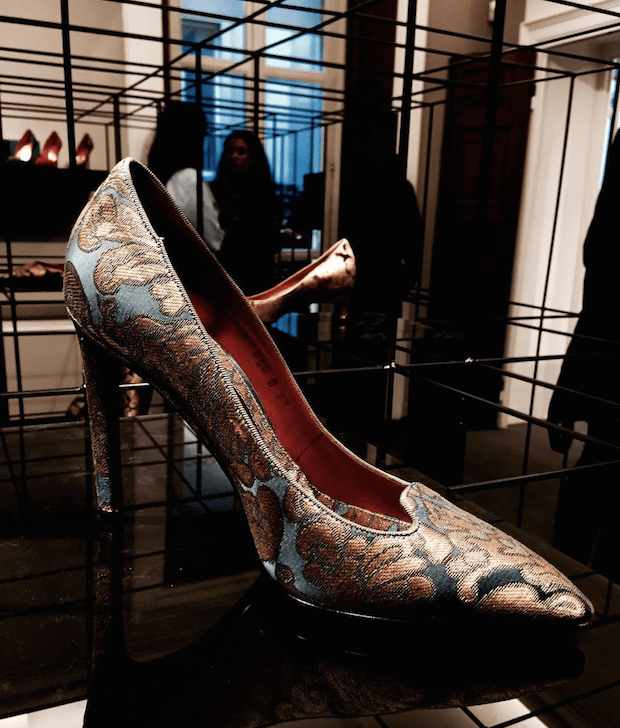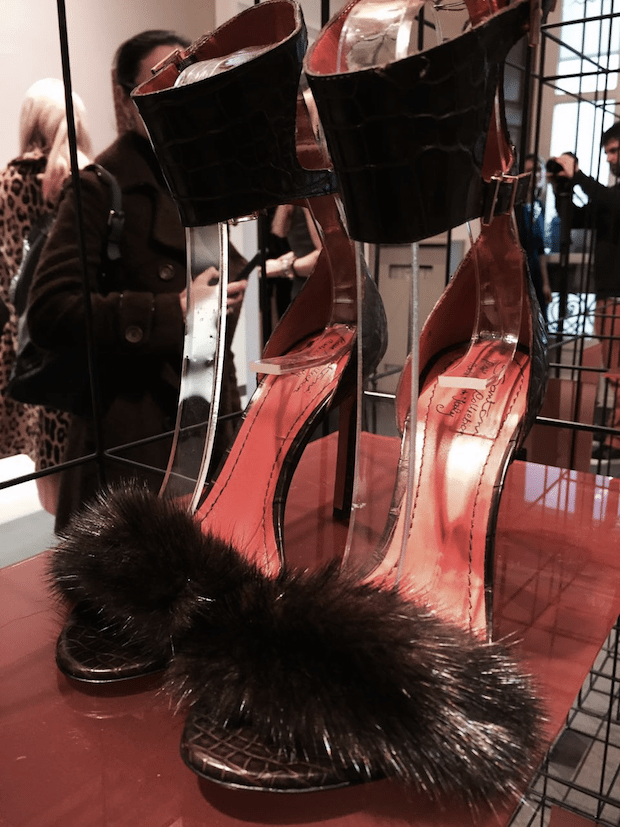
SantonI CEO Giuseppe Santoni. (Courtesy Photo)
Created by founder Andrea Santoni in 1975, Italian footwear brand Santoni has been promoting the cultural heritage of Italian craftsmanship for 40 years. Since its founding, the family brand has grown on an international landscape with approximately 490 employees and a turnover rate of more than 55 million euros. The brand’s legacy has been handed over Andrea’s son Giuseppe, who serves as its CEO and is overseeing its China expansion plans.With two stores in Beijing, three in Shanghai, one in Hong Kong, and one in Shenyang, it’s currently eyeing further expansion in China and nearby Asian destinations.
This year’s Santoni Fall/Winter 2015/16 collection presented during Milan Fashion Week was a look back at 1970’s glamour and escapism. A royal and dense color palate of burgundy, forest green, teal peacock, and dark maroon were combined with metallic hues. The precious materials included crocodile, python, fox, and mink, giving an extremely “over-the-top” eccentric look and feel for this season.
At the presentation, we sat down with company CEO Giuseppe Santoni to learn about his future plans for the China market and how the brand’s family-run heritage is a plus for Chinese consumers.

Shoes from Santoni's F/W 2015/16 collection at Milan Fashion Week. (Yanie Durocher)
Can you give some background on your history with Santoni?#
My father started the business in the ‘70s; those were years of great prosperity and development in Italy. Many successful companies were created in that period. My father’s long view really made the difference: he wanted to be different, unique, and to produce an excellent product instead of simply a good one. This choice is the first prerequisite of our success now.
Then, of course, so many things have changed in 40 years, and everything happened fast. Already strong in our savior fare and artisanal mastery, we invested in innovation, technologies especially for the product development, and, of course, in design. The introduction of the women’s line, of the informal shoes and sneakers, and recently of bags and accessories collection were very important and strategic steps to continue to be successful and to expand the business.
I’ve never thought to do anything else than inheriting my family business. Since I was a child, I loved spending my time in my father’s workshop, which was on the base floor of the house we lived in that time. Year after year, I learned all the steps of shoemaking, it was a joke for me, and I was so fascinated by just observing my father and his workers while making shoes. Then, once finished my studies, I immediately entered the company and my father gave me the role of opening new markets, with full responsibility from the very beginning.
To reach the Chinese market, how important are traditional values compared to modernity and innovation?#
We have always been acting between tradition and innovation, it’s part of our DNA. We firmly want to remain loyal to the artisanal savoir faire we achieved over the years, and to continue to produce shoes by the book. This is the only way to create perfect objects.
On the other hand, we need to evolve, innovate, use new technologies, propose contemporary design, introduce new collections and lines, and open new markets. We do it by investing in innovation, and this does not contradict our artisanal soul and craftsmanship.

Shoes from Santoni's F/W 2015/16 collection at Milan Fashion Week. (Yanie Durocher)
What are the three biggest challenges your brand is facing with APAC and specifically China?#
When we started the business in this region, of course, we had to face many challenges—first of all, the cultural diversity and the need to understand it before doing even one step. Also, the tastes can be quite different sometimes, and during these years, we learned how to deal with Chinese customers: what is important to them, what are the mistakes you don’t have to make? I think that we now have good knowledge and experience in this market.
How do you balance the price and image perception from Chinese domestic customers traveling abroad?#
The traveling customers definitely represent an important part of our clientele. Our product is conceived for a specific target: self-confident and sophisticated men and women, who most of time time are globe-trotters, or at least open-minded people who are keen on details.
They’re people who don’t merely follow the trend. They have their own idea of style, their outfits are never ordinary, and there is always something unique in the objects they choose. They are connoisseurs, able to understand the value and the beauty of a product, and to wear it in a personal way. For this kind of people, the high value for money of Santoni products is something evident: they know they are purchasing something really special with high-quality and unique design, and they are ready to pay for it because they consider the price absolutely fair and reasonable.
What is your brand’s strategy for the next year in the APAC region?#
I’m convinced that the China market is mature enough to understand all the quality, design, and uniqueness of Santoni products. We want to reinforce our presence in key locations like Shanghai, Beijing, and Hong Kong, of course, by opening new mono-brand boutiques. We are also monitoring other locations like Hangzhou, Macau, and also some possibilities in Vietnam, Korea, Thailand, Singapore, and Indonesia. Most of all, we are also focused on e-commerce and social media channels, which are now so important for the brand’s expansion in this market.

Shoes from Santoni's F/W 2015/16 collection at Milan Fashion Week. (Yanie Durocher)
What is the importance of social media for your brand and its marketing strategy in China?#
Social media is now also important for luxury brands. They need a dedicated strategy focused on the single markets. In China, this phenomenon is even more evident and stronger than in other countries, so one of our main targets for 2015 is to increase our presence and visibility in the most renowned online media and social media as well.
Given your brand awareness in China, how are you educating Chinese customers on artisanship, craftsmanship, and “made in Italy” heritage?#
We simply tell our story, which is a story of excellence, quality, craftsmanship, and heritage. Santoni products embody and express all these values at the highest level. We often organize events and trunk shows inviting our top or potential top clients who have the exclusive possibility to experience the art of shoemaking and to talk to our artisans. The Chinese high-end consumer is usually extremely interested in our craftsmanship and care for details.
Can you give us details on future collaborations, brand ambassadors, and new projects your brand in planning on having next year?#
We will go on with our existing partnerships, by proposing new products and initiatives with Mercedes AMG, IWC Schaffausen, and Rubelli. Our partners share the same vision, philosophy, and values where the products we create together are always inspired by excellence and perfection.
Santoni for AMG is our exclusive line of sports shoes for driving and also racing, inspired by specific AMG cars. For IWC, we produce alligator straps colored by hand for the most important timepieces like Portofino and Portuguese. With Rubelli’s fabrics, we’ve created precious masterpieces of great elegance and sophistication.
This interview was originally conducted in Italian.
Yanie Durocher is a lifestyle and fashion blogger at The Marginalist.